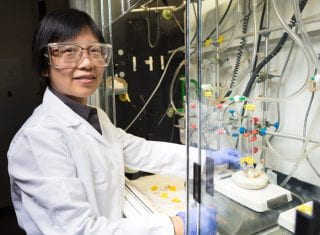NSF Awards Almost $500,000 to Study Novel Nanostructures
 The National Science Foundation awarded $493,595 to U of A professor of chemistry Jingyi Chen to study synthetic approaches to new hollow nanostructures made of non-precious metals.
The National Science Foundation awarded $493,595 to U of A professor of chemistry Jingyi Chen to study synthetic approaches to new hollow nanostructures made of non-precious metals.
Hollow nanostructures have become an emerging area of study because they outperform their solid counterparts in various applications for catalysis and electrolysis. Their superior physicochemical properties stem from their low mass density, high porosity and large reaction surface-to-volume ratio. The hollow structure increases the surface to volume ratios while optimizing material use.
Currently, rarer noble metals are favored in various nanostructures because they are stable and less prone to corrosion while being easier to reduce from a high oxidation state to a low oxidation state. Noble metals include gold, platinum, silver, iridium and others. Due to their scarcity, they are more costly, so Chen’s goal is to identify more multifunctional nanocomposite materials of earth abundant metals as lower-cost alternatives to noble metals.
“We aim to fundamentally understand the nanochemistry behind the controlled synthesis of earth abundant metals and related compounds at the nanoscale,” Chen explained. “This, we hope, will enable us to enrich the toolbox of nanomaterials for applications in energy conversion and storage, sensing, and environmental remediation at a lower cost.”
As part of this project, Chen and her research team will provide opportunities for research students from underrepresented groups to contribute to the training of a diverse, globally-competitive future workforce.
The results from this project will also serve as the basis of videos for educational outreach through the Chemistry Rules YouTube channel, the Nanochemistry 101 Boot Camp and the annual Science Day event at the regional Scott Family Amazeum.
The NSF grant comes as part of the Macromolecular, Supramolecular and Nanochemistry Program in the Division of Chemistry and the Established Program to Stimulate Competitive Research.
This story also appeared in the University of Arkansas News publication.

